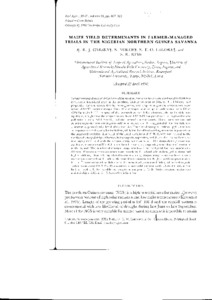| dc.contributor.author | Carsky, R. |
| dc.contributor.author | Nokoe, S. |
| dc.contributor.author | Lagoke, S.T.O. |
| dc.contributor.author | Kim, S. |
| dc.date.accessioned | 2019-12-04T11:23:36Z |
| dc.date.available | 2019-12-04T11:23:36Z |
| dc.date.issued | 1998 |
| dc.identifier.citation | Carsky, R., Nokoe, S., Lagoke, S. & Kim, S. (1998). Maize yield determinants in farmer-managed trials in the Nigerian northern Guinea savanna. Experimental Agriculture, 34(4), 407-422. |
| dc.identifier.issn | 0014-4797 |
| dc.identifier.uri | https://hdl.handle.net/20.500.12478/4054 |
| dc.description.abstract | Farmer-managed tests of Striga hermonthica-resistant maize varieties were conducted in 1994 in a moderately intensified zone in the northern Guinea savanna of Nigeria. Field history, soil properties, current season fertility management, and crop management observations were recorded for 37 farmer-managed trials. Site averages for maize grain yield varied from 300 to 4000 kg grain ha−1. In spite of the tremendous variability observed, the grain yield was significantly higher for the striga-resistant hybrid 8321-18 compared with an improved open-pollinated variety, STR Syn-W, and the farmers' current variety. Correlation analysis and stepwise regression analysis of grain yield on measured variables suggested that maize yield was a function of plant density for all three varieties. The rate of nitrogen fertilizer application was an important variable only for the hybrid, while the day of first weeding was most important for the improved varieties. The yield of the local varieties and STR Syn-W was related to the number of emerged striga at harvest in the stepwise regression, and the yield of the local varieties was highly correlated with the striga-damage score on maize. The striga-damage score was significantly lower on 8321-18 than on the other varieties, suggesting some degree of resistance in the hybrid. The number of emerged striga was lower for the hybrid but not significantly different. Farmers were almost unanimous in ranking the hybrid as least damaged by striga and highest yielding. Besides being related to maize variety, striga-damage score was lower if crop residue was observed on the field at the time of site confirmation. Highest yields (approximately 4 t ha−1) were recorded on fields near the homestead (compound fields) where soil organic carbon values were 2.0–2.5%. Realization of maize yield potential in the absence of manure or fertilizer will only be possible on long-term compound fields. Striga-resistant maize can maintain high yields under S. hermonthica infestation. |
| dc.language.iso | en |
| dc.subject | Striga Hermonthica |
| dc.subject | Maize Variety |
| dc.subject | Cropping Systems |
| dc.subject | Cereal Production |
| dc.subject | Fertilizers |
| dc.title | Maize yield determinants in farmer-managed trials in the Nigerian northern Guinea savanna |
| dc.type | Journal Article |
| dc.description.version | Peer Review |
| cg.contributor.affiliation | International Institute of Tropical Agriculture |
| cg.contributor.affiliation | Ahmadu Bello University |
| cg.contributor.affiliation | International Agricultural Research Institute |
| cg.contributor.affiliation | National University, Korea |
| cg.coverage.region | Africa |
| cg.coverage.region | West Africa |
| cg.coverage.country | Nigeria |
| cg.isijournal | ISI Journal |
| cg.authorship.types | CGIAR and developing country institute |
| cg.iitasubject | Weeds |
| cg.iitasubject | Maize |
| cg.iitasubject | Crop Systems |
| cg.iitasubject | Plant Production |
| cg.iitasubject | Nutrition |
| cg.accessibilitystatus | Limited Access |
| local.dspaceid | 99340 |
| cg.identifier.doi | https://doi.org/10.1017/S0014479798004074 |

